|
In view of the
ban on public meetings, the Coronavirus has put paid to the normal range of
Surrey Vintage Vehicle Society outside and inside gatherings. We have therefore encouraged all
our members to take
photographs instead of any of their allowable distancing machinery and share them on
our website. Many of our
Members are of the 'elderly variety' so were hankered deep down thinking of
survival rather than escape, but some have been 'socially cycling' and
have sent photos to
us. PHOTOS WELCOME !!
Our Membership Secretary Chas Moody
apart from being keen on vintage cars is also a very keen 'two-wheels man' and
is not particularly choosy if he falls off a motorcycle or a bicycle. Just as
the Coronavirus lock-down was about to happen, he had taken his 1914 Triumph TT
Roadster Motorcycle on the "
Virtual 81st Pioneer Motorcycle Run - 2020 " of which some
photos are on our website,
Chas is also a regular 'modern' sports biker, and he has a much broken leg to prove it,
- he is also a collector of old bicycles. One of the oldest he had was a
"Penny Farthing" which we could control relatively expertly,
except for the time he turned into the Dog & Duck Car park bit sharpish at
one of our Sunday lunchtime meetings and took out the side of our then Chairman's newly
restored Jaguar XK120.
Chas is also a convert to photography and has now dent some lovely photos to
prove it. The first is of his visit to nearby Lingfield Village and the famous
'Cage'. The Lingfield Cage is a very small single room building next to the
village pond and was built in 1773 by the good folk of Lingfield to house their
local drunks, petty thieves, rustlers and ruffians. These buildings were
normally built from stone, had a stone roof, a small stone built chimney, a
single door and a slit window. Mostly they were square in shape but some were
round and some had domed roofs. They were known as the 'village lock-up', the
'cage', the 'tower', the 'watch house' or the 'round house'. Many were built
adjacent to the village pond and were provided with adjacent stocks. They were
normally looked after by the local constable and his staff, and were also used
as holding cells for villains prior to them going in front of the local
magistrates in the nearest bigger town. They were replaced in 1839 by local
police stations having their own holding facilities. The Cage is next to the
village pond called the "Gun Pond" or 'Gun Pit Pond'. The pond area is
now much modernised and brick surrounded.
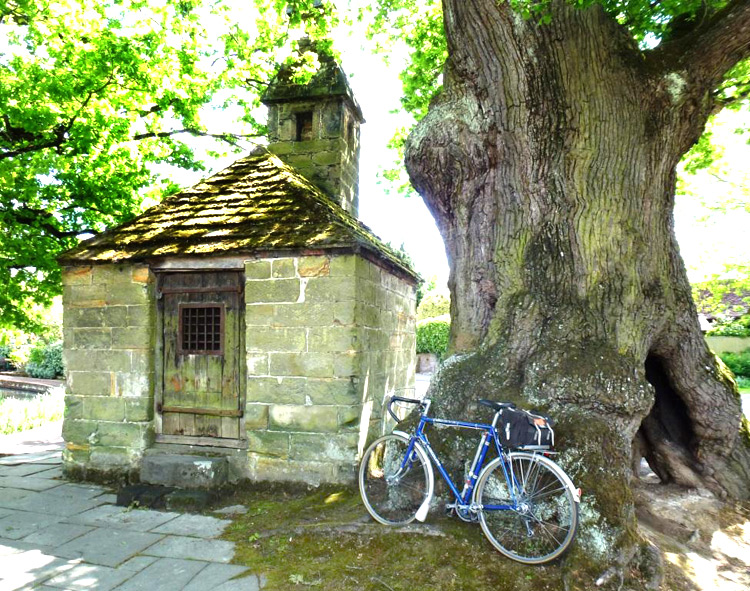
The cycle is a 1977 Viscount 'Aerospace Sport',
purchased to provide transport to work which was an eight-mile journey and paid
for itself in saved train fares in about six months. The bikes were manufactured
by The Trusty Cycle Company Ltd. which perhaps was more familiar for its
children's cycles and whilst being mass produced, the Aerosport range possessed
many features found on more expensive hand-built machines. The frames were
apparently made from aerospace quality lightweight steel tube, fillet brazed
without lugs and good quality accessories were used. At £88.00 basic price, the
bikes were extremely good value for a cycle of this specification. Innovative
features included cartridge bearing bottom bracket assemblies and sealed ball
race wheel bearings.
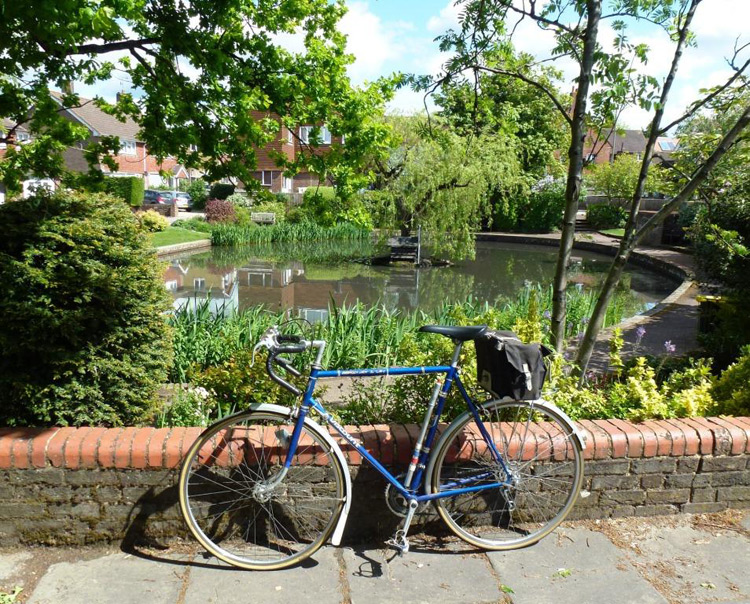
The second of Chas Moody's
visits was to Westerham and the statue of Sir Winston Churchill on the village
green. This statue is of some interest to the SVVS Chairman Bozi Mohacek who is
of Yugoslav/Croatian origin. The bronze statue of Churchill was unveiled in 1969
having been sculpted by Oscar Nemon. It stands on a base of Yugoslav granite
which had been donated by the then President of Yugoslavia Marshal Josip Broz
Tito as a symbol of Yugoslav soil, in homage to "Churchillís leadership in
the Second World War". It should be noted that Westerham is the
nearest town to Churchill's wartime home, the Chartwell Estate. What may not be
so well known is that Churchill's connections with Tito went very much deeper.
Churchill's son Randolph had, with Winston Churchill's approval, been parachuted
into the impenetrable Yugoslav mountains during the later states of Word War Two
to liaise with Tito, this when the Brits decided Tito was probably on the
winning side. Tito was at that time very close to being captured by the Germans
but managed to escape. Randolph subsequently also flew to the remote off-coast Adriatic island of
Vis which had become Tito's stronghold. The airplane apparently crashed and
Randolph was injured. He was flown to Italy and later returned to take charge of
the military mission in Croatia. By this time Randolph was a bit of an
embarrassment and "drunk most days", and less than the perfect
English gentleman. - So the connection between the Churchills and Tito,
and with Yugoslavia, were actually much closer than may at first sight be
suggested.
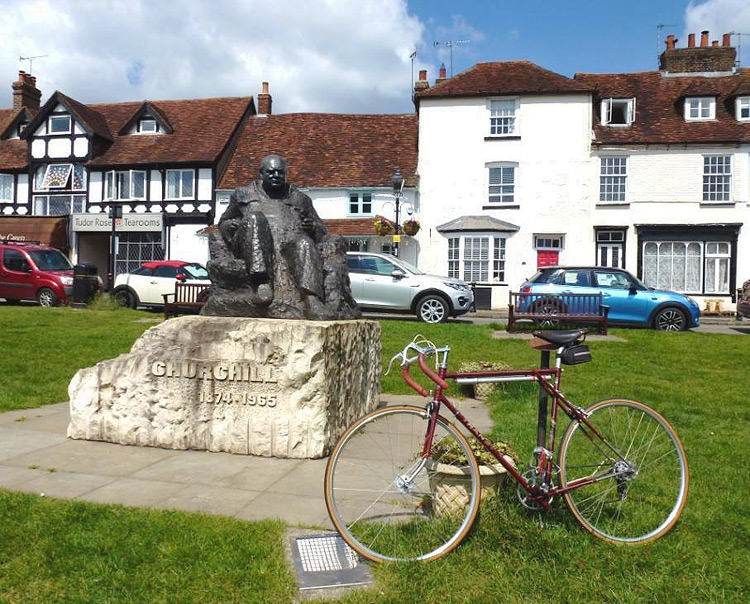
The machine that Chas went to Westerham on was a 1953 Thanet
'Silverlight'. Hand-built in Bristol, these machines of unconventional design
were the idea of proprietor Les Cassell. Unusual features were the use of
1" diameter tube for the three main frame tubes, normal frames having
larger size tube for the front down tube and seat tube. The bottom bracket was
cradled by the frame tubes instead of the tubes being directly connected to it
and the seat stays were roughly parallel with the down tube, being connected to
both the seat tube and top tube to form a triangulated structure. Silver solder
was used to join the tubes to the frame lugs instead of brass which was normally
used in frame manufacture. Approximately 583 cycles were produced of this design
of which about 100 are known to survive.
Not to be undone on the ancient bicycle front, the SVVS
Chairman Bozi Mohacek rummaged through the cowshed
milking-parlour in amongst the resting agricultural machinery because he
remembered seeing an old dusty much-unused bicycle there. Sure enough, propped
up against an old rusty paraffin dispensing drum was real proper nurse's
bike with wicker basket. Enquiries with Mrs Chairman advised that the bike had
belonged to her elder sister while she was training to be a nurse at Guys Hospital
in London in 1950s. She apparently used it as her main means of transport. It
then came to the Farm and had occasionally been used by mother-in-law to go
shopping on to the local village.
My specific memory of the bike was a couple of decades ago being asked by the
in-laws to get it
mobile again because it was needed to be used in a theatre production of, I think,
'The importance of being Earnest' where it was to wheeled on and off the stage
by Miss Prism. To my surprise the front wheel turned and the tyres were flabby
but did contain adequate air to confirm that they were partially pumped up. Much
liberal use of wire brush and oil got the chain mobile, which then proved that
the rear wheel can be turned freely. The wheel was fitted with a Surmey Archer three
speed hub which likewise was in need of many squirts of oil. Additional oil was
needed to the steering head, and quantities of penetrating oil to the saddle
adjusting bolt to make the saddle adjustable. The bike duly made it debut on the
stage and behaved implacably. So much so, it was called on for another theatre
production a year or so later.
It then returned to the milking parlor where it continued to rest gently for a
decade or so until I took it out yesterday to investigate it more in order to
write this item about it. To my great surprise the machine was very much as I
had left it except that the tyres were a grungy mess of sticky decaying rubber
much misshapen. So I was greatly relived I would not be able to be persuaded to
take up cycling into the countryside. Instead, I decided to do a bit more
research into what exactly it was. To my great surprise it turned out to be a
RUDGE. To me a Rudge was an Ulster TT winning racing motorcycle not a rusty old
pushbike!
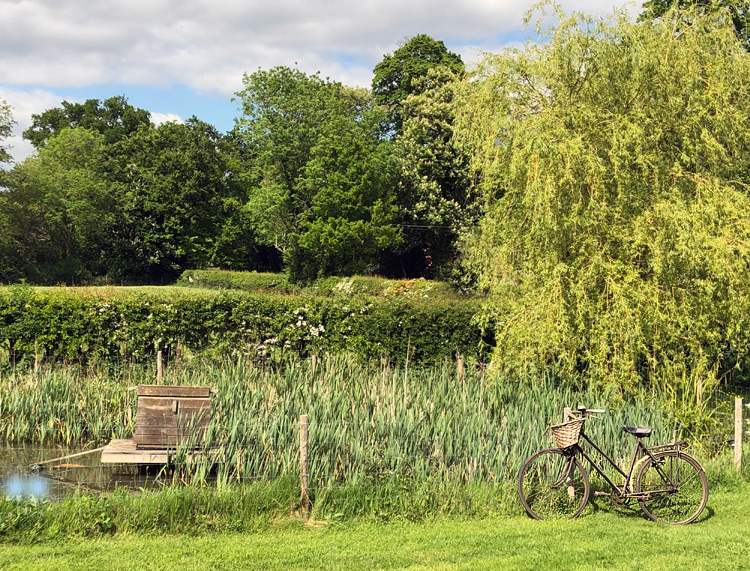
Seems however that the Rudge bicycle was made by Rudge-Whitworth Cycles formed
by amalgamation of Whitworth Cycle Co and Rudge Cycle Co in 1894. No apparent
connection with the famous Whitworth. The company was successful and were
producing 25,000 cycles a year by 1897, and by 1934 it had become Coventry's
largest cycle manufacturer. Quite impressive considering the cycling boom was
largely on the decline. For that very reason, Rudge-Whitworth Cycles had been
diversifying since 1912 into detachable wheels (in competition to Riley) and had
started in motorcycle manufacture. They were very successful in making winning
Grand Prix and TT racing motorcycles through the 1920s and 1930s.They even went
into the car market by launching in 1912 the Rudge Cyclecar powered by 750 cc
single and using the Rudge multi-speed transmission, with belt drive.
As already mentioned, they were in 1934 Coventry's largest cycle manufacturer
but, due to the great depression, they encountered financial difficulties. The
company was restructured under the same name. They ceased motorcycles in 1939
but carried on with bicycles. In 1943 the company was bought by Raleigh and the
name continued to be used on bicycles up to 1961.
Our bike, after much scraping off of dirt and rust, and guessing at worn out
transfers, seemed to be a Rudge Whitworth Pathfinder. The Rudge red hand logo
comes from the original Whitworth company. Our bike is a 'step-over' or 'lady's
standard bicycle' which had been manufactured in various variants since
1904 and remained so for many years with a curved upper downtube and frequently
with a fully enveloping chain-guard. The bike with parallel downtubes like on
ours were made from the early 1930s and remained visually unchanged into the
1950s. There was a change from rod brakes to cable brakes and introduction of
Sturmey-Archer three speed hub. A range of types of handlebars was available
from sit-up-and-beg to drop-down sports. Our one has the Sturmey-Archer three
speed hub and, short of researching the part numbers, ours would seem to be of
cca 1951/2 vintage. Now safely returned to the milking-parlour for a further
decade or two of rest, by when it may be 'discovered' by my kids, - or theirs?
Another of our Members who apart from being keen on vintage
cars, is also a very keen 'two-wheels man', is our French contributor Michel
Gossett. Michel cycles the lanes of Surrey and has occasionally come across
Chas Moody doing the same. Being French Michel is naturally an owner of
two Citroens, a 1924 5CV and 1956 2CV, but does have a couple of British Jags
(albeit with the steering wheels on the wrong side), a Moggy and has a Triumph
police twin motorcycles. He was also the owner of the Connaught Formula
One single seater as raced by Bernie Ecclestone, and a Bond tree-wheeler which
refused to rot away in the garden because it was made of fiberglass. I wanted it
but Mrs Chairman threatened divorce.
Michel sent us this picture with the comment: This is a photo of my bike which I
bought at the local Boy Scout jumble sale; as you can see it is not a
"sports" version ; it must be four times heavier than the bikes
encountered on my daily run. Sometimes I think that it should be nice to run a
very light bike but, after all, the purpose is to do some physical exercise, so
there would be not much point !" We do however note from the
photograph that Michel needs in these cold northern climates quite a paraphernalia
of warm gear to go cycling. We note a thick jacket, scarves, gloves and thick
socks. I wonder what he needs on the coldest day of the year?
The bike is a Dawes Street Life 'step-over' or 'lady's bicycle', sometimes
referred to as a Dutch bicycle, made in the early 1970s. Dawes is a British
bicycle manufacturer in the Midlands who started making motorcycles and bicycles
in Birmingham in 1906 as Humphries & Dawes. The company split in 1926 with
Dawes Cycles Co primarily promoting itself as a racing cycle manufacturer. They
manufactured most of the components of the bike themselves, like mudguards,
brakes, pedals etc, thereby keeping control of quality. The company grew through
the 1950s and 1960s and were making over 1,000 bicycle a week during the
1970s. They diversified into "unisex" and small wheel
"shopping" bikes, available as either fixed frame or foldable. Between
1978 and 2001 the company was sold five times ending up with production in Asia.
The head office remains in Birmingham and is still developing new models.
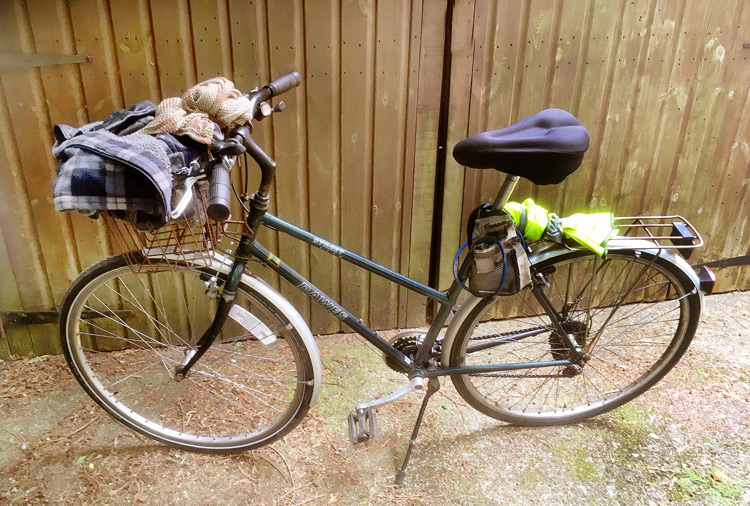
Michel also supplied a photo demonstrating his cycling prowess of a few months
ago. He says " I was at the beginning of the run from my home on our
very steep downhill lane (10% incline which gets snow/ice bound in mid winter).
For some reason , I needed to adjust the cover on my saddle so I stood a bit on
the pedals in order to adjust the saddle with one hand, while the other hand was
steering the bike and applying the front brake. I then realised that the bike
needed to slow down lots more .. so I applied more brake ... a bit too much. The
result was similar to the photo : for half a second everything was still ;
beautifully balanced on the front wheel, - in perfect equilibrium.
Unfortunately this did not last long and I got some very sore knees !
 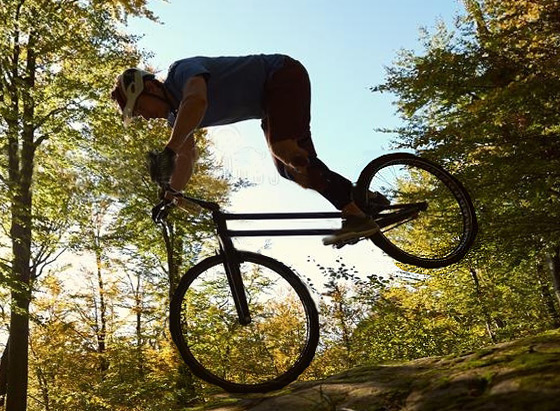
Go to Recent Venues
Page
PICTURE GALLERY INDEX
|







